Common Turbidity Misconceptions
- Monitoring wells are not water supply wells. Supply wells are designed to provide large volumes of relatively clear water for some type of consumptive use. Unfortunately, the image of a crystal clear sample coming from a well being the equivalent of a good groundwater sample is embedded in our psyche.
- Many, if not most, monitoring wells are not installed in aquifers that can be used for water supply. Monitoring wells are often located in low permeability form
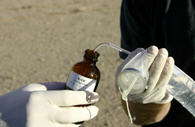 ations containing a large percentage of silt and clay sized particles. In these formations it is impossible for a filter pack to be sized to exclude silt and clay size particles without clogging. The good news is that monitoring wells only need to supply a relatively small volume of sample, preferably at a slow rate from a specific zone for analytical purposes.
ations containing a large percentage of silt and clay sized particles. In these formations it is impossible for a filter pack to be sized to exclude silt and clay size particles without clogging. The good news is that monitoring wells only need to supply a relatively small volume of sample, preferably at a slow rate from a specific zone for analytical purposes. - Unlike bottom filling bailers, the flat, flexible, top-loading HydraSleeve does not appreciably increase turbidity by stirring up sediment in the bottom of the well, even if cycled up and down. The HydraSleeve is not a bailer!
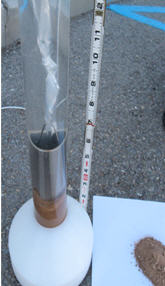
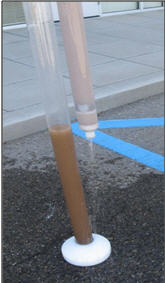
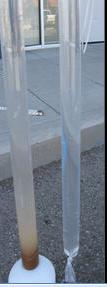
First photo shows sediment in the bottom of a clear column with an old-style HS weight resting on the bottom. Second photo shows what happens when the bailer is cycled once in that column; and the third photo shows the HydraSleeve results after cycling 7 times.
- When turbidity is found in the HydraSleeve it usually is a result of naturally occ
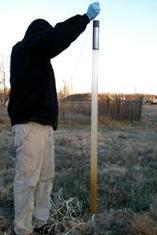 urring material (precipitates, iron bacteria etc.) suspended in the well that slowly settles to the bottom over a period of time. Picture sedimentation in a lake bed or the sea floor. In some wells, sediment may accumulate on the top of the closed check valve while the HydraSleeve is left in the well between sampling events. When the HydraSleeve is pulled upward to collect a sample, the check valve opens and the accumulated material enters the sleeve and moves to the bottom of the bag. The longer the time the HydraSleeve is left in the well, the more time the sediment has to accumulate above the check valve. It should be noted that the sediment is naturally occurring within the well and is in chemical equilibrium with the water in the well.
urring material (precipitates, iron bacteria etc.) suspended in the well that slowly settles to the bottom over a period of time. Picture sedimentation in a lake bed or the sea floor. In some wells, sediment may accumulate on the top of the closed check valve while the HydraSleeve is left in the well between sampling events. When the HydraSleeve is pulled upward to collect a sample, the check valve opens and the accumulated material enters the sleeve and moves to the bottom of the bag. The longer the time the HydraSleeve is left in the well, the more time the sediment has to accumulate above the check valve. It should be noted that the sediment is naturally occurring within the well and is in chemical equilibrium with the water in the well.
The photo at the right shows a HydraSleeve sample using a SuperSleeve top weight. The sediment collected on the check valve and subsequently entered the bag as detailed above. The formation was glacial till.
So, knowing what we now know about turbidity, there are some instances where we would want to minimize turbidity in the HydraSleeve sample. Using a 2-inch well as an example the following optional methods can be used to retrieve a clearer, less turbid, sample (if that is your goal). The options are ranked from least to most turbid. Rule of thumb: the more sample volume required, the greater chance of elevated turbidity levels.
- Use a SpeedBag. The in/out method utilitzed with the Speedbag reduces sample turbidity. It only collects sediment that is suspended in the sample zone at the time of collection. This eliminates the accumulation of in-well sediment on top of the sampler over time.
- Use standard 625 ml HydraSleeve, bottom weighted. Can be left in well indefinitely prior to sample collection. Depending on the well, sediment may accumulate on the check valve.
- Use standard 1-liter HydraSleeve, bottom weighted. Can be left in the well indefinitely prior to sample collection. Depending on the well, sediment may accumulate on the check valve. Larger diameter may accumulate more sediment over time.
- Use standard 625 ml HydraSleeve, top weighted. Can be left in well indefinitely prior to sample collection. Depending on the well, sediment may accumulate on the check valve.
- Use standard 1 or 2-liter SuperSleeves, top weighted. Can be left in well indefinitely prior to sample collection, but sediment may accumulate on check valve. Very large diameter and tight fitting top weight may accumulate more sediment over time than other configurations.
